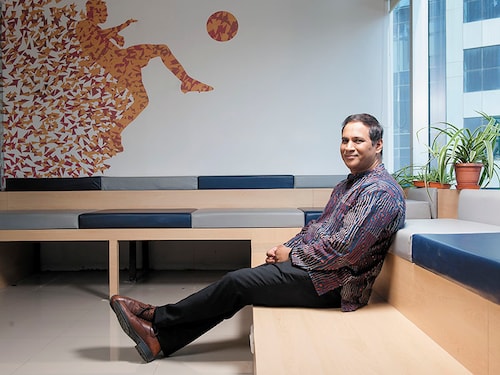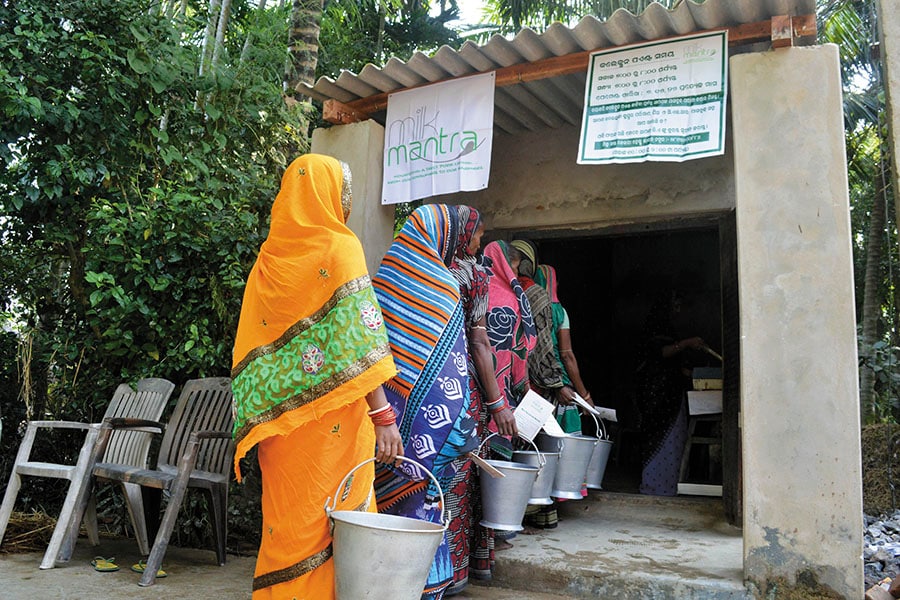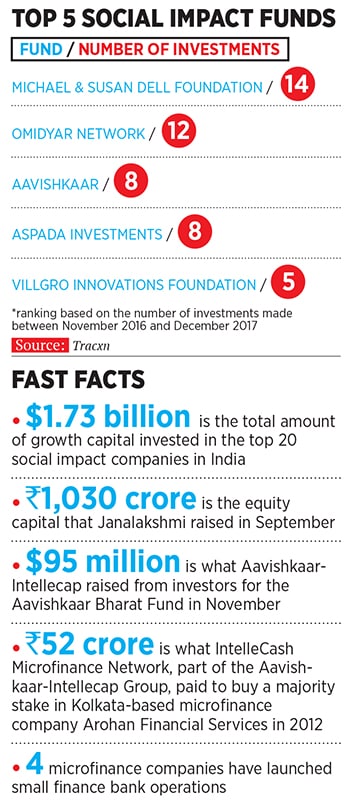Aavishkaar-Intellecap's Vineet Rai: The forester who turned financier
Vineet Rai went from chasing elephants in the jungles of Odisha to setting up impact investment firm Aavishkaar-Intellecap that today has ₹3,800 crore in assets under management


Image: Mexy Xavier
If you come and tell us you are trying to change the world, chances are we will not give you money,” says Aavishkaar’s Vineet Rai, deadpan. His venture equity funds, initially set up in 2001, and now worth almost $300 million have been steadily making investments across India’s low-income states, building enterprises, creating jobs and lifting people out of poverty. He continues, “Rather than you saying it, does your business show it? Then we will give you money.”
That’s not all. Rai dislikes being called an ‘impact investor’, that is, someone who invests with the intention of generating a positive social impact along with financial returns. “They [impact investors] carry a cross on their shoulders about changing the world. That’s not what we want. Our work is to make investments in distressed or difficult areas. If in the process the world changes, that’s great,” the 46-year-old tells Forbes India.
Rai’s story isn’t just about being contrarian. Instead, his is a story of extraordinary risk-taking and tightly-managed expansion. Consider Aavishkaar’s investment in Milk Mantra in 2011. The Odisha-based dairy company existed as a mere plan on paper at the time. And tilling of land or animal husbandry wasn’t commonplace in the rural regions of the state. At the front end, too, the organised procurement of milk in eastern India stood at 10 percent, compared to the national average of 23 percent, says Srikumar Misra, the Milk Mantra founder.
“Capital would generally never go there to create a dairy,” reasons Rai. But he sniffed an opportunity. Given the fairly large number of cities in Odisha, Rai knew that the demand for packaged milk was prevalent. If a local supply chain could be built, it would create employment for thousands in the state’s remote regions.
So he bought into Misra’s vision to create an “ethical sourcing model”. The first step was to tie up with banks to provide loans to farmers to buy cattle farmers would then be trained to breed their cattle in a way that would up the output of milk milk collection centres would be set up as would transparent payment methods so that farmers got their due. Packaging, distribution and retailing across Odisha was also part of the plan. “Our idea was to build the entire supply chain to overcome the trust deficit consumers have for perishable foods milk is often thought to be adulterated or stale,” says Misra, adding that Aavishkaar put in about ₹5 crore of seed capital. A collection centre set up by Milk Mantra, a dairy firm in Odisha in which Aavishkaar investedToday, Milk Mantra works with more than 50,000 supplier farmers, has 400 milk collection centres and distributes packaged milk and milk products across Odisha, Jharkhand, West Bengal and Chhattisgarh. It raked in ₹150 crore in revenue in FY17, up from about ₹18 crore in FY13. While Aavishkaar still remains invested, other investors like Eight Roads Ventures (previously Fidelity Growth Partners India) have also swooped in.
A collection centre set up by Milk Mantra, a dairy firm in Odisha in which Aavishkaar investedToday, Milk Mantra works with more than 50,000 supplier farmers, has 400 milk collection centres and distributes packaged milk and milk products across Odisha, Jharkhand, West Bengal and Chhattisgarh. It raked in ₹150 crore in revenue in FY17, up from about ₹18 crore in FY13. While Aavishkaar still remains invested, other investors like Eight Roads Ventures (previously Fidelity Growth Partners India) have also swooped in.
In fact, for every $1 invested by Aavishkaar, its portfolio companies have raised greater than 4x follow on capital, says Rai. He is quick to point out that the difference between Aavishkaar and a traditional venture capitalist is that the former will invest in areas where the ecosystem is under-developed or even non-existent. “Generally, capital and talent, like water coming down a hill, flow to Mumbai, Delhi, Bengaluru, Chennai—places where you have infrastructure,” he says. This understanding, he adds, occurred to him when he was heading Grassroots Innovations Augmentation Network (Gian), an Ahmedabad-based incubator set up by the Gujarat government to help farmers convert their ideas into businesses.
Cobras and Kraits
Rai’s journey to being appointed the CEO of Gian in 1998 was quite an adventurous one. He grew up in Rajasthan, moving from city to town, wherever his father’s work as a hydro-geologist for the government took him. Rai’s early ambitions to join the Indian Army—watching officers patrol the borders of Rajasthan had made him starry-eyed—were thwarted after three failed attempts at the examination. Unsure of the direction he wanted to take, he enrolled himself for a degree in forestry at the Indian Institute of Forest Management, Bhopal, at the insistence of a friend’s father. “I had no clue what I was going to do there, but the campus was beautiful,” says Rai with a chuckle. He was 20 at the time.  After graduating, he joined paper-maker Ballarpur Industries and was posted in the deep, forested lands of Odisha, where the company sourced its raw material. He spent a little over three years on the job, fending off cobras and kraits while managing the forests. But when the Rais were expecting their first child, his wife insisted he find a safer job. He applied for various positions, including that of a car salesman in Muscat, but found—not unsurprisingly to him—that nobody wanted anyone with a background like his. Except the Indian Institute of Management, Ahmedabad—they were looking to fill a research position for a project on bio-diversity. Rai moved to Ahmedabad, took up the job, but realised after a year that the work didn’t excite him. “After chasing elephants in Odisha, this (writing research papers) seemed a bit boring,” he says. That’s when the Gian offer landed in his lap.
After graduating, he joined paper-maker Ballarpur Industries and was posted in the deep, forested lands of Odisha, where the company sourced its raw material. He spent a little over three years on the job, fending off cobras and kraits while managing the forests. But when the Rais were expecting their first child, his wife insisted he find a safer job. He applied for various positions, including that of a car salesman in Muscat, but found—not unsurprisingly to him—that nobody wanted anyone with a background like his. Except the Indian Institute of Management, Ahmedabad—they were looking to fill a research position for a project on bio-diversity. Rai moved to Ahmedabad, took up the job, but realised after a year that the work didn’t excite him. “After chasing elephants in Odisha, this (writing research papers) seemed a bit boring,” he says. That’s when the Gian offer landed in his lap.
For three years Rai scouted for innovative ideas that would help farmers improve efficiencies, and converted those ideas into businesses. One farmer had created a downward tilting bullock cart that allowed for fertiliser to trickle down into the fields while tilling, an activity otherwise done manually. But while making a business out of it, Rai struck upon a key learning: That nurturing an innovation into a full-fledged business requires an entrepreneur, not an innovator, in the lead and since that entrepreneur is taking a risk, he requires risk capital. “The biggest challenge is not in finding the entrepreneur or the innovation but in providing the risk capital,” points out Rai. That, coupled with high quality talent, could build businesses that would, as he puts it, make poor people rich.
Armed with this understanding, Rai approached Gian’s board members for a change in strategy, but they were uninterested. So Rai, who had been talking to a few investors about his “theories”, quit his job and decided to deep dive into setting up a fund that would change rural India.
But raising money was difficult. “Nobody wanted to give money to a forester who wanted to do finance,” says Rai. Finally, through the connections he had made while at IIM-A and Gian, he managed to present his ideas to a handful of expats living in Singapore. “Vineet had no clue about finance, but his knowledge about what was happening on the ground in India was unparalleled,” says Jayesh Parekh, co-founder of Sony Entertainment Television and now managing partner at early stage VC fund Jungle Ventures, who was one among those gathered and also the first to promise seed money. In all, Rai managed to raise SG $100,000 (about ₹27 lakh then) from the group, and the name Aavishkaar—meaning innovation in Hindi—was born there.
Rai formally set up the fund in early 2001. But he needed more funds. “It was very difficult to get money. It took me five years to raise ₹5 crore,” he says. Not only was the idea of using the venture capital method to serve the rural, low-income market radical at the time—Aavishkaar claims to be one of the early, if not the earliest, adopters globally—but even purely commercial businesses found it hard to raise venture money.
High on returns
Despite being a slow starter, Rai persisted with his vision and in 2002 also set up Intellecap—short for “intellectual capital”—with initial money from his wife Swati. The idea was to provide non-financial support, including research and consultancy services, to rural enterprises and help them scale. Like Aavishkaar, Intellecap, too, struggled initially. But, by 2005, when the microfinance industry took off, Intellecap rode the wave, advising and eventually incubating institutions like Utkarsh, Suryoday Micro Finance and Grameen Koota, among others. Today, Intellecap advises not just microfinance institutions but those across sectors and geographies. Meanwhile, Aavishkaar made a few investments too. One of the early ones—in 2007—was in Rangsutra, an artisan collective that supplies apparel to Fabindia. At the time, it was a not-for-profit based in a remote area in Rajasthan, on the India-Pakistan border, and worked with craftspeople from across the region and surrounding areas, including Rajasthan and Uttar Pradesh. When founder Sumita Ghose approached Rai for money, he advised her to shift to a for-profit model. After deliberating over it for six months, she did so and Rai put in ₹23 lakh for a 25 percent stake. Ghose used the funds to develop the backend of her supply chain and within four years gave Rai an exit at an internal rate of return (IRR) of 39 percent. “Aavishkaar had faith in our enterprise when no one else did,” recalls Ghose.
Meanwhile, Aavishkaar made a few investments too. One of the early ones—in 2007—was in Rangsutra, an artisan collective that supplies apparel to Fabindia. At the time, it was a not-for-profit based in a remote area in Rajasthan, on the India-Pakistan border, and worked with craftspeople from across the region and surrounding areas, including Rajasthan and Uttar Pradesh. When founder Sumita Ghose approached Rai for money, he advised her to shift to a for-profit model. After deliberating over it for six months, she did so and Rai put in ₹23 lakh for a 25 percent stake. Ghose used the funds to develop the backend of her supply chain and within four years gave Rai an exit at an internal rate of return (IRR) of 39 percent. “Aavishkaar had faith in our enterprise when no one else did,” recalls Ghose.
Chennai-based Equitas Microfinance was another big success: Aavishkaar invested $1.5 million in 2008 and netted 13 times when it went for an IPO in 2016. Enticed by these returns, more limited partners came in and raising money became easier. “I later managed to raise ₹375 crore in seven months, up from ₹5 crore in five years,” says Rai. Today, he manages six funds worth almost $300 million, including one that makes investments in Indonesia, Sri Lanka and Bangladesh. The focus continues to be on providing high-risk capital to early-stage enterprises based out of rural and semi-urban regions—Aavishkaar is the first institutional investor in more than 92 percent of the 58 businesses it has invested in so far. While most of the investments are in the financial services space, other sectors that Aavishkaar backs include agriculture, health care, education, energy and sanitation.
Moreover, limited partners include heavyweights like the International Finance Corporation, New York-based pension fund TIAA, and the Dutch development bank FMO. “Vineet has managed to excite and attract a phenomenal LP base,” says Parekh.
While the venture equity funds are grouped under Aavishkaar Venture Management Services, the firm has over the years created an entire ecosystem to service the needs of enterprises: IntelleGrow to provide venture debt, IntelleCash to meet the working capital and business loan needs of small and medium enterprises, and Arohan to cater to microfinance borrowers. These entities, along with Intellecap, together form the Aavishkaar-Intellecap Group that today has ₹3,800 crore ($590 million) of assets under management (AUM). “We can provide anything from ₹5,000 to ₹100 crore across debt and equity,” says Rai, who claims to be on track to achieve ₹4,500 crore ($700 million) of AUMs by March 2018.
With impact investing growing in India—$5.2 billion came in between 2010 and 2016, according to McKinsey—Rai’s targets don’t seem out of reach. Moreover, a total of 48 exits were seen during the period of which 24 were made by Aavishkaar-Intellecap alone. Returns of 3.1 times were given to investors, says Rai. In fact, following Aavishkaar-Intellecap’s success, a number of players including Omnivore Partners, Asha Impact and Lok Capital followed suit.
Says Parekh: “Vineet got the entire impact investment ecosystem going. He’s like the Pied Piper.”
First Published: Jan 15, 2018, 07:09
Subscribe Now